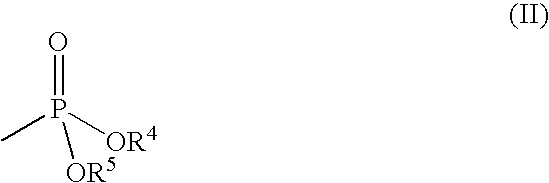Anti-flocculant coating composition
a technology of coating composition and anti-flocculation, which is applied in the direction of electrochemical generators, sports apparatus, solid balls, etc., can solve the problems of slowing down the flocculation process and difficult formulation work
- Summary
- Abstract
- Description
- Claims
- Application Information
AI Technical Summary
Benefits of technology
Problems solved by technology
Method used
Image
Examples
example 1
Synthesis of Unimodal Polymer Dispersion
[0013] A unimodal polymer dispersion was prepared as follows. A 5-liter, four necked round bottom flask was equipped with paddle stirrer, thermometer, nitrogen inlet and condenser. In the initial kettle charge, a mixture of surfactant, ammonium bicarbonate, and deionized water was added to the kettle and heated to 82° C. under a nitrogen atmosphere. A monomer emulsion (ME) was prepared by mixing deionized water, sodium laurylether sulfate, butyl acrylate, methyl methacrylate, 1-dodecanethiol, and phosphoethyl methacrylate (61 weight % active strong acid monomer). With the kettle water at 82° C., the following materials were added in order: ME and rinse water, a mixture of 0.1% iron sulfate solution and 1% ethylenediaminetetraacetic acid, tetrasodium salt solution, a solution of tert-butyl hydroperoxide in deionized water, and a solution of isoascorbic acid in water. The reaction temperature was kept at 80° C. After stirring for 5 minutes, the...
example 2
Synthesis of Unimodal Aqueous Emulsion Copolymer
[0014] A unimodal polymer dispersion was prepared as follows. A 5-liter, four necked round bottom flask was equipped with paddle stirrer, thermometer, nitrogen inlet and condenser. In the initial kettle charge, a mixture of ammonium bicarbonate, the dispersion made in Example 1, and deionized water, was added to the kettle and heated to 80° C. under a nitrogen atmosphere. A monomer emulsion (ME) was prepared by mixing deionized water, surfactant, butyl acrylate, methyl methacrylate, 1-dodecanethiol, and phosphoethyl methacrylate (61 weight % active strong acid monomer). With the kettle water at 82° C., the following materials were added in order: ME and rinse water, and a mixture of 0.1% iron sulfate solution and 1% ethylenediaminetetraacetic acid, tetrasodium salt solution. Two cofeed solutions (70% tert-butyl hydroperoxide in deionized water and isoascorbic acid in deionized water) were gradually added over a period of 130 minutes. ...
example 3
One-Pot Synthesis of Bimodal Aqueous Emulsion Copolymer
[0015] A bimodal polymer dispersion was prepared as follows. A 5-liter, four necked round bottom flask was equipped with paddle stirrer, thermometer, nitrogen inlet and condenser. A mixture of 29.0 grams of surfactant, 3.4 grams of ammonium bicarbonate, 88.9 grams of an acrylic polymer emulsion (100 nm, 45% solids), and 950 grams of deionized water was added to the kettle and heated to 80° C. under a nitrogen atmosphere. A monomer emulsion (ME) was prepared by mixing 550 grams of deionized water, 64.5 grams of surfactant, 1040 grams of butyl acrylate, 910 grams of methyl methacrylate, 2.5 grams of 1-dodecanethiol, 40 grams of phosphoethyl methacrylate (61 wt % active strong acid monomer), and 10 grams of methacrylic acid. With the kettle water at 80° C, a mixture of 25 grams of 0.1% iron sulfate solution and 1.7 grams of 1% ethylenediaminetetraacetic acid, tetrasodium salt solution was added. The ME was added to the kettle at 8...
PUM
| Property | Measurement | Unit |
|---|---|---|
| Tg | aaaaa | aaaaa |
| Tg | aaaaa | aaaaa |
| weight % | aaaaa | aaaaa |
Abstract
Description
Claims
Application Information
 Login to View More
Login to View More - R&D
- Intellectual Property
- Life Sciences
- Materials
- Tech Scout
- Unparalleled Data Quality
- Higher Quality Content
- 60% Fewer Hallucinations
Browse by: Latest US Patents, China's latest patents, Technical Efficacy Thesaurus, Application Domain, Technology Topic, Popular Technical Reports.
© 2025 PatSnap. All rights reserved.Legal|Privacy policy|Modern Slavery Act Transparency Statement|Sitemap|About US| Contact US: help@patsnap.com



